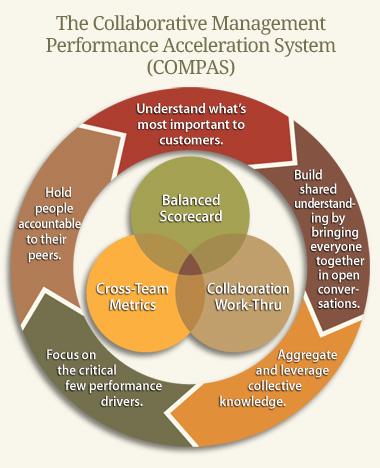Hack:
The Collaborative Network: Redesigning Management for the Wiki World
Management has a design problem. The century-old hierarchical model that has worked so well throughout the Industrial Age is increasingly out of sync with the unprecedented business challenges created from the combination of accelerating change and escalating complexity that now defines the dimensions of our new Wiki World.
In a recent survey of over 1500 chief executive officers, IBM reported that the rapid escalation of complexity is the biggest challenge confronting organizations, and more than half of CEOs doubt their ability to manage it. Given that nine out of ten organizations fail to execute their strategies, it’s no wonder that CEOs are very worried about whether or not they have the wherewithal to manage in an increasingly complex world.
However, there are companies, such as Best Buy, Google, Linux, W.L, Gore & Associates, and WholeFoods who aren’t concerned about the twin challenges of increasing change and complexity. That’s because they know that the key to mastering change and complexity is to create agile collaborative networks, not slow-moving bureaucratic hierarchies.
We are at a unique juncture in history as we find ourselves catapulted from the industrial world we knew so well and thrust into the very unfamiliar Wiki World and its completely different set of rules. We are at a tipping point in the evolution of management where traditional executives are confronted with an unprecedented business reality for which most are totally unprepared. In this new world, digital technology has made networks far smarter and far faster than hierarchies, and has consequently created a deep management crisis as traditional executives stubbornly persist in holding onto their hierarchies by trying to tweak a 19th century management model to tackle 21st century problems. However, the simple fact that they don't want to acknowledge is that it can't be done. We really are in a new world with a new set of rules.
The fundamental assumption behind the construction of hierarchies is that the smartest organization is the one where the smartest individuals have the power to command and control the work of others. In bureaucracies, the central role is the boss and all the workers are very aware of what's most important to the boss. Consequently, hierarchies are designed to work inside-out. Traditional managers often assume that everything needed to be successful out in the marketplace is contained inside the organization. This assumption reinforces the notion that bosses are more important than customers. In fact, in inside-out organizations, there is no real value attached to customers as they are often viewed merely as a market mechanism for the transaction of products into profits. This explains why hierarchies often define the domain of management as inside the corporation.
Managing innovation at the speed of change is now the central business issue across all industries. The new economy of the Wiki World is all about change - continuous unrelenting change. If business leaders want to survive the current management crisis and learn to successfully manage at the new pace of change, they will need to do an extreme management makeover and redesign their organizational architecture around the set of principles used by a new breed of business leaders who are mastering the twin challenges of change and complexity. These innovative leaders understand that, if you want to tackle 21st century problems, you need to work outside-in by starting with what's most important to customers. They understand that power has more to do with being connected than being in charge, which is why they also know that the smartest organization is the one that has quick access to the collective intelligence of both its customers and its workers. In the 21st century, the domain of management is both inside and outside the corporation.
The digital revolution has given us the unprecedented capacity for mass collaboration. This means that large numbers of people can work directly and effectively together without having to go through a central organization - and they can do it smarter, faster, and cheaper. In a world reshaped by Google, Wikipedia, Linux, and iTunes, bureaucratic hierarchies are rapidly becoming obsolete. Power really is about being connected, which is why the solution for business effectiveness in the WikiWorld means scraping the hierarchies and using the network as the fundamental model for 21st century management.
A fast-emerging alternative management model that assumes the best organizations are networks and not hierarchies is steadily redefining the ways large numbers of people work together. While the vast majority of traditional leaders fail to recognize what is in plain sight, the examples of the successful practitioners continue to grow. These include W.L. Gore & Associates, Google, Linux, Wikipedia, Amazon, Zappos, Threadless, Best Buy, Whole Foods, Craigslist, eBay, Goldcorp, Starbucks, and Proctor & Gamble. Each of these companies has been built as a collaborative network designed to leverage its collective intelligence, and each of these companies is radically changing the ways businesses do business in the 21st century.
When we look this group of bellwether organizations, there are five disciplines that they have in common. These disciplines, which are virtually absent in traditional bureaucracies, are the fundamentals that define the new rules for managing in a Wiki World. These five disciplines of collaborative networks are:
- Understand What’s Most Important to Customers. The best companies are customer-centric; they build their strategies around what matters most to customers and design their processes to give delighting customers priority over pleasing bosses. These organizations understand that the purpose of a business is not to create shareholder wealth, but rather to deliver customer value because without customer value, there is no shareholder wealth. This explains why the management of Zappos, when pressured by its Board to realize greater "efficiencies" and reduce its customer service costs, instead raised $200 million to buy out its Board and sell itself to Amazon, who wanted to emulate rather than diminish the customer service operation. What the managers at Amazon and Zappos both realize is that being customer-centric means that customer service is an investment and not an expense, and that as long as that investment is producing a substantial ROI, you don't kill the investment.
- Build Shared Understanding by Bringing Everyone Together in Open Conversations. Companies that successfully manage at the pace of accelerating change have innovative processes that enable them to effectively integrate diverse points of view and reach agreements on their disagreements. This is the "secret sauce" behind the meteoric success of Wikipedia. The online encyclopedia has a very useful rule that promotes its remarkable effectiveness: all articles will present a neutral point of view. This means that there can only be one rendition of every article and that the proponents of differing factions have to dialogue to form a shared understanding. The wiki platform is, in effect, a virtual town square where authors of differing points of view work together to form the consensus that becomes their shared understanding. Wikipedia is living proof that, with the right process, we can find ways to accomplish what is rarely achieved in hierarchies: to find a solution that allows us to agree about our disagreements.
- Aggregate and Leverage Collective Knowledge. In a knowledge economy, organizations are fundamentally intelligence systems. Today’s most intelligent organizations no longer leverage individual intelligence by constructing bureaucratic hierarchies; they build collaborative networks to leverage their collective intelligence because they understand that nobody is smarter and faster than everybody. This is a lesson that I learned firsthand as the leader of the operations of the Blue Cross Blue Shield Federal Employee Program, more commonly known as FEP. FEP is a business alliance of the 39 independent Blue Cross Blue Shield Plans to provide health insurance for 4.5 million federal employees and their family members. In the late 1990's, we needed to undo two decades of no growth and low performance. The cornerstone for building our collaborative network was an innovative meeting format known as the Collaboration Work-Thru. A Collaboration Work-Thru is a facilitated meeting process for working through differing points of view and achieving the best possible solution by accessing the most untapped resource in almost every organization, the collective knowledge of its own people. By learning how to aggregate and leverage our collective intelligence, we dramatically increased our market share by 16 points and increased our operating performance by over 30 percent to historically unprecedented high levels. We accomplished our goal of becoming a high growth, high performing business.
- Focus on the Critical Few Performance Drivers. The most effective leaders know that management is about creating the future. And when they are good at creating the future, they never have to explain the past. That’s why smart leaders don’t focus on outcome measures; they focus on the leading indicators that drive the outcomes. Most businesses are riveted on outcome measures because these are the metrics that matter most to Wall Street. However, these performance metrics are poor management tools because they are invariably lagging indicators. Collaborative networks have two measurement systems. In addition to the usual outcome metrics, they also track the leading indicators that drive performance results. These driver measures are excellent management tools because they provide the opportunity to proactively manage better outcomes. Companies that excel at this discipline use a process, such as the Balanced Scorecard, to identify the critical few drivers of their business and then make the current metrics of these driver measures available across the collaborative network to drive local performance.
- Hold People Accountable to Their Peers. The secret to mastering the unprecedented combination of accelerating change and escalating complexity is to make sure that no one in the organization has the authority to kill a good idea or keep a bad idea alive. In the best businesses, leaders aren’t bosses; they’re catalysts and facilitators orchestrating collaborative networks. These networks are far smarter and faster than hierarchies because holding people accountable to their peers is the great enabler of the collaboration necessary for speed and innovation. This final discipline is the glue that makes W.L. Gore & Associates self-organized structure so effective. At Gore there are no supervisors, no organization charts, and no chains of command because all work is accepted rather than assigned. No one has the authority to kill a good idea or to keep a bad idea alive. Gore's innovative approach to accountability may be the driver that explains how this company has made a profit in every year since its founding in 1958. At Gore everyone evaluates 20 people and everyone is evaluated by 20 people, which provides plenty of incentive for engaging in collaboration and committing to achieving results. When you think about it, probably 80% - 90% of the work done by the typical worker in any company involves interaction with about 20 people. What Gore has done is turn those 20 people into internal customers and provide an incentive to focus on what's most important to those customers. An important observation from the Gore experience is: To build a truly collaborative organization, you need to provide incentives for collaboration.


Yes, and ...
control is about decision making authority.
Instead of moving information to the authority, move authority to the information.
This requires thoughtful deconstruction of the larger decisions, technical competence among employees and clarity of mission.
leader-leader.com/blog
- Log in to post comments




You need to register in order to submit a comment.